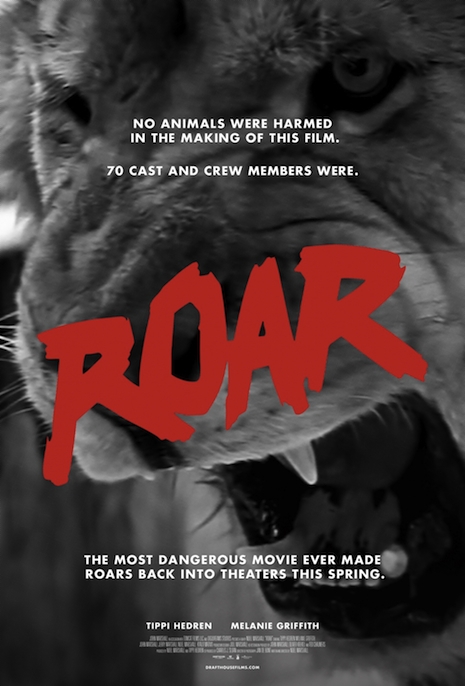
Roar (1981) has been called “the most dangerous movie ever made.” How did it earn such a dubious distinction, you ask? Well, the cast and crew of the film worked with more than 130 wild animals—including panthers, tigers, lions, and elephants—that were allowed to roam free while the cameras rolled. The actors often appear to be genuinely terrified as these animals pursue them, knowing they could strike at any moment (and they often did). 70 people were injured during the making of the film.
Roar was the brainchild of Noel Marshall, one of the executive producers of The Exorcist, and his wife, actress Tippi Hedren, most famous for her lead role in Alfred Hitchcock’s The Birds. Over a period that lasted more than a decade, Marshall and Hedren, along with Noel’s sons John and Jerry and Tippi’s daughter Melanie Griffith, lived with these animals, while simultaneously shooting Roar. The entire family starred in the film, which Noel wrote and directed.
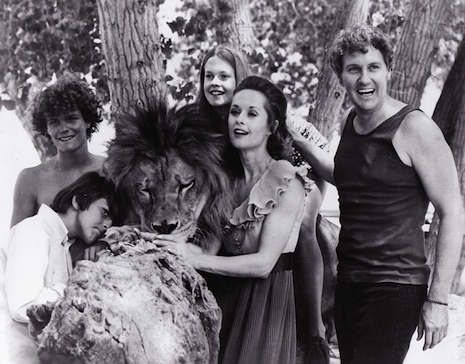
Roar has also been called the most expensive home movie ever made, costing $17 million. It tanked upon release, grossing just $2 million. Marshall, who died in 2010, would never direct another motion picture.

Roar defies categorization. On the surface, it’s an action/adventure film, but there are also elements seemingly taken from horror movies, documentaries, and slapstick comedies. At times it feels like you’re watching a bizarro-world live-action Disney film! This movie is totally captivating, comical, suspenseful, and terrifying. In short, Roar is nuts.
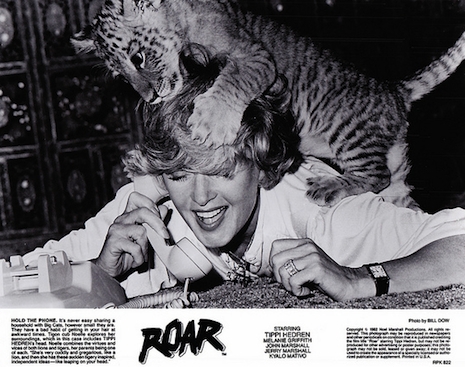
Alamo Drafthouse CEO/founder Tim League is a big fan of the film. In fact, he’s so passionate about Roar that he became an expert on its history and secured the rights to re-release it. A limited theatrical run in select cities begins April 17th, with Blu-ray/DVD/On Demand availability coming this summer.
I emailed Tim League a number of questions about this one-of-a-kind motion picture.
It took eleven years to make Roar—what took so long?:
Tim League: I like to think of Roar as a sort of Boyhood where the family expands beyond the mom, dad and children to include an adopted family of more than 130 lions, tigers, leopards, panthers and jaguars. Tippi Hedren and Noel Marshall first had the idea to shoot Roar back in 1971 when they were on safari and saw an abandoned house overrun with lions; they thought the concept of a family living in a house with lions would make an excellent premise for a film. Daktari had been wildly popular a few years prior, and they figured Roar would be a similar hit while upping the stakes. So, they immediately sought out world-renowned big cat experts to find out if such a thing could be done. These experts responded unanimously with words to the effect of, “You must be brainsick. Do NOT do this.” Undeterred, Marshall and Hedren set about the ten-year process of bringing big cats into their Hollywood home in small batches, one after another, to acclimate the animals to the family. The theory was that if they lived together with the lions from the time they were cubs, they would then escape injury when on set with these “familiars.” The other factors that caused delays with the production were two floods that wiped out the entire set, one raging forest fire, and times when the entire crew would quit after a particularly harrowing day. They also lost their financing halfway through the production and stopped to gather personal funds to get the film across the finish line. Most experts consider Roar to be the most disaster-plagued film in the history of Hollywood.

Areas of Africa are thanked in the credits, so I assumed Roar was filmed there, but I’ve also read that it was shot in California. What’s the truth?:
Tim League: Pick-up shots were done in Africa, notably the incredible opening scene of Noel racing the giraffe. The rest of the film was shot north of Los Angeles in what is now the Shambala Preserve. Tippi Hedren still oversees Shambala today. As this was entirely a family affair, another of Noel Marshall’s sons, Joel, served as Production Designer and Art Director.
Marshall and Hedren put themselves, the crew, and most of the cast—including their own children—in harm’s way. This would seem irresponsible to most. How did they see it?:
Tim League: Everyone knew the risks but continued to persevere because they believed in the project. Melanie Griffith left the production when it first began shooting, telling her mother, Tippi Hedren, that she didn’t “want to come out of this with half a face.” She ultimately decided to return and finish the picture with her family, though she ended up being mauled and requiring facial reconstructive surgery. In an interview with the Daily Mail in October 2014, Tippi expressed regret at the decision to keep lions in their home, acknowledging that they “were stupid beyond belief.”

All told, 70 cast and crew members were injured during the making of the film. What were some of the more severe injuries? Were any life threatening?:
Tim League: Noel got the brunt of it. You can see him dripping real blood many times throughout the film. One of the elements that makes viewing Roar so tense is that every performance is heightened. Actors can be delivering the simplest line of dialogue, but the pitch is ratcheted up about 20% above normal and there is a constant manic energy. You can see real fear in everyone’s eyes and hear it in their on-camera pleas for help. As to injuries, Noel suffered multiple puncture wounds that eventually gave him gangrene, as lion bites become easily infected because of Pasteurella multocida bacteria on their teeth and claws; Tippi broke her leg in a stunt with an elephant and also suffered from gangrene; Director of Photography Jan de Bont was scalped and required more than 120 stitches; and Melanie Griffith was mauled, resulting in more than 50 stitches and facial reconstructive surgery. No one was killed.

How much of the action were the animals allowed to dictate? How bad would things get before Marshall would stop filming an especially violent scene?:
Tim League: The lions are given writing credits in Roar, if that gives you any idea. In particular, the lions and tigers playing with the boat and repeatedly pulling it back to shore, the elephant destroying the boat, and the lion riding the skateboard were all improvisational moments. Honestly, there really isn’t much of a plot to the movie. The structure was left open because each day they had no idea what the lions were going to do, so much of the film was improvisational. Despite the litany of injuries, my sense is that Noel and his crew tried to be as safe as possible, given the circumstances.
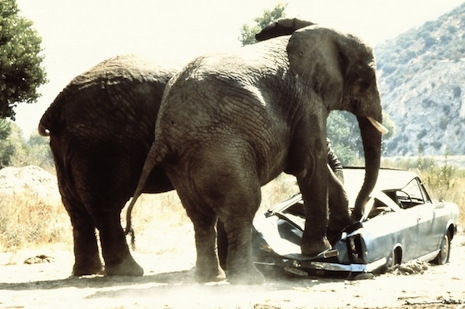
Part of what makes watching Roar such an unnerving experience is that the actors look genuinely frightened. Did they fear for their lives? Melanie Griffith seems especially freaked out. Was this just good acting or was it real emotion?:
Tim League: That is not acting; that is fear captured on camera. There is a scene where Melanie is pinned to the floor while a lion is biting and swatting her. She is screaming for her mom, and Tippi is in turn screaming for John and Jerry. Those were real cries for help. There is another scene where a jar of honey falls off a shelf and covers Tippi’s face, and a panther comes in and licks off the honey. They had never tested this shot before, and Tippi was petrified that instead of a lick, the panther would opt for a bite.

I imagine for close-ups make-up was applied, but is most of the blood the actors appear to shed real? A few scenes are quite gruesome.:
Tim League: I don’t know the answer for sure, but my sense is that an extremely small amount of the $17 million dollar budget was spent on make-up. For sure, the initial scenes with Noel’s bloody hand were “practical effects.”
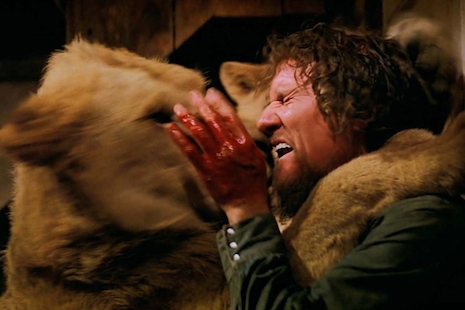
I understand Marshall and Hedren were passionate about wildlife preservation, and that the film was, in a sense, propaganda, but there are several moments in Roar when the animals are seen creating terror. What do you think Marshall was ultimately attempting to convey with the film? What was his message?:
Tim League: The ultimate message they wanted to put forth was to stop the decimation of African wildlife by hunting and trading in furs and ivory. I can certainly stand behind that message. The narrative of the film doesn’t always directly drive that home, though. The overwhelming emotion I get from the film is fear rather than a passion to preserve.
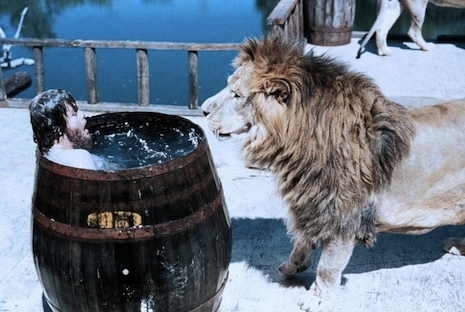
When did you first see Roar? What was your initial impression?:
Tim League: I was first turned on to Roar at the Telluride Film Festival. The film wasn’t playing, but I was in line with film director Greg Marcks. We were talking about Drafthouse Films’ previous release Miami Connection, and he asked if I had ever seen Roar. He was a huge fan of the movie and gave me the complete rundown. I managed to watch it a few weeks after Telluride and was blown away. That’s when the hunt began.
What drove you to re-release the film? What’s your current view of Roar?:
Tim League: I had never seen anything like Roar. I was also really surprised that almost no one I talked to, including some pretty deep-track, serious cinephiles, had never heard of this film. Roar felt like a fantastic discovery and I had the urge to share it with as many people as possible. As to my current feeling, it remains the same. I love this movie. I mentioned Boyhood in the beginning: Richard Linklater received incredible (and justified) praise for his commitment to film a family over twelve years. Roar documented a real-life family over eleven years while they were being attacked by more than 130 lions, tigers, leopards, panthers and jaguars. Now that is an achievement.
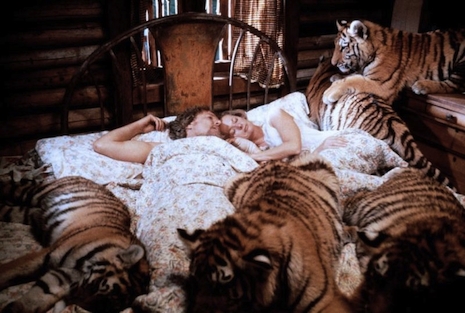
Check out Drafthouse Film’s Roar page to see if the film is headed to your town. If you’re in the Los Angeles area, note the special screenings at Cinefamily, in which John Marshall will be on hand for a Q&A, and there will be a cast and crew reunion.
Drafthouse Films has provided Dangerous Minds with an exclusive clip from Roar. Here we see John and Jerry Marshall doing their best to avoid the animals that seem to be lurking around every corner. The scene is a great example of the amazing shots Noel Marshall managed to get amidst the chaos, as well as Jan de Bont’s top-notch cinematography. It also highlights the film’s claustrophobic vibe and precarious on-set atmosphere.
If you’ve yet to be convinced that Roar is indeed the most dangerous movie ever made, you surely will be after watching the trailer.